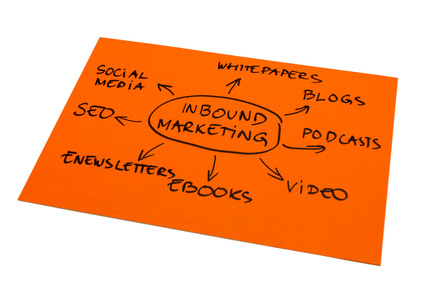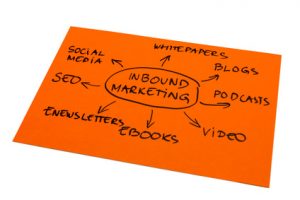Traditional marketing is becoming obsolete. As more consumers turn to the web to buy products and services, its time for small business owners to acquire clients by shifting to a new marketing strategy. It’s time for small businesses to go inbound!
What is Inbound Marketing?

Dharmish Shah, Brian Halligan, and David Meerman Scott introduced inbound marketing to the marketplace in their 2009 book of the same name, Inbound Marketing.
Inbound marketing employs an attraction principle. Through the use of quality content, inbound marketing pulls potential clients to your business. It builds credibility and trust with your audience by gently and graciously taking them through the buyers journey.
How does it Differ From Traditional or Outbound Marketing?
Traditional, outbound marketing uses a push technology. Some marketing specialists refer to it as “interruption marketing” because that’s what it does — it disrupts your day through email blasts, direct mail, and cold calls.
On the other hand, inbound marketing capitalizes on several critical changes in buying trends, such as:
- Increase in online search. A recent study discovered that 97% of all consumers research online for products and services before they buy.
- Buyers want to buy but they don’t want to be sold.
- Consumers are more sophisticated in their buying approach. They are looking for relevant information. In fact, 56% unsubscribe from newsletters because the content is no longer applicable.
Inbound marketing attracts potential clients by using keywords, social media, and blogging. It converts visitors to your website to leads by making valuable offers and content available for downloading. Leads become clients when trust and credibility are built through automatic workflow emails. And, it uses smart content to continue to delight your clients.
What’s the Big Deal?
In addition to leveraging online search behavior, inbound marketing gives small business owners the one thing that is a premium — TIME!
A business built on an inbound marketing strategy is like having a 24/7 sales team. You don’t always need to be “there” (i.e., workshops, networking, special events, etc.) to generate valuable leads for your business.
It’s so 21st Century!





 1. Start my day with “me”. I love to read. It sparks my creativity and fuels my brain cells. Before the flurry of activities begin, I meet each day at 5 am with a cup of coffee and my Kindle.
1. Start my day with “me”. I love to read. It sparks my creativity and fuels my brain cells. Before the flurry of activities begin, I meet each day at 5 am with a cup of coffee and my Kindle.
 It’s tempting to offer hefty discounts to clients. Whether your choice to markdown your fee is to seduce clients into an initial purchase or acquiring more of your services,
It’s tempting to offer hefty discounts to clients. Whether your choice to markdown your fee is to seduce clients into an initial purchase or acquiring more of your services, 
 There are two fundamental decision choices
There are two fundamental decision choices 
 Blogging was agonizing, painful, time-consuming, and stressful. Even at my rapid-fire writing pace (said with tongue in cheek), I was uncertain what I would write. What did I possibly have to say that would fill 30 blog posts? Anxiety over topics, and the fact that it took 4 hours to write a 500-word blog post was enough to send me to the snack drawer!
Blogging was agonizing, painful, time-consuming, and stressful. Even at my rapid-fire writing pace (said with tongue in cheek), I was uncertain what I would write. What did I possibly have to say that would fill 30 blog posts? Anxiety over topics, and the fact that it took 4 hours to write a 500-word blog post was enough to send me to the snack drawer!
 Make a list of everyone with whom you spend time.
Make a list of everyone with whom you spend time.
 Admittedly, I seldom pay attention to such announcements. They become a passing notation in the day of a busy entrepreneur…until a Twitter post caught my eye. Ray Hennessey (@Hennesseyedit), Editorial Director @Entmagazine, Casual-Free Market Economist, Latin Scholar, & Former Plumber, tweeted, “
Admittedly, I seldom pay attention to such announcements. They become a passing notation in the day of a busy entrepreneur…until a Twitter post caught my eye. Ray Hennessey (@Hennesseyedit), Editorial Director @Entmagazine, Casual-Free Market Economist, Latin Scholar, & Former Plumber, tweeted, “



